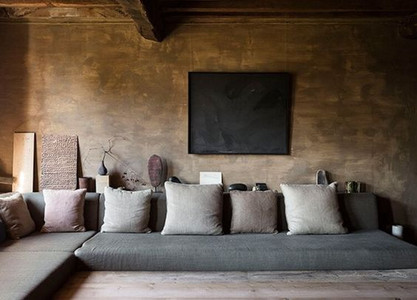All You Need to Know About Wabi-Sabi Interior Design
- Amina Husain

- Nov 27, 2021
- 4 min read
Updated: May 26, 2023
‘Stress-free living’ is probably the key defining interior design trend for coming years. After the uncertain times the world is living in since 2020, having the time to relax in a calming interior environment is looking very attractive to many of us around the world. Wabi-Sabi philosophy is the perfect answer to creating such an environment that has been inspiring many interior stylists for a few years now.
In this blog, we will explore what this philosophy means and how we can incorporate this relaxed, uncommon interior design look and way of life into our spaces.
All You Need to Know About Wabi-Sabi Interior Design
Meaning
Wabi derives its meaning from the root 'wa', referring to peace, harmony and balance. In the zen spirit, the Wabi person is the one who is able to find happiness in the little things, who is free from anger and greed, one who understands the wisdom of nature.
Sabi means "flower of time", which refers to the natural flow of time, decay, degradation and the understanding that beauty is ephemeral.
The combination of the two is the essence of philosophy: the beauty of the imperfect and respect for the passage of time.
It is a Japanese concept, rather a philosophy of acknowledging the nature of things and finding beauty and serenity in it—and in that sense, it opposes many typical contemporary and modern decoration rules. The idea disregards the need for perfection and symmetry in everything. Pared down to its barest essence, Wabi-Sabi is the Japanese art of finding beauty in imperfection and profundity in nature, of accepting the natural cycle of growth, decay, and death. The art of imperfection, raw materials and the effects of the passage of time are the essence of the Wabi-Sabi philosophy.
Wabi-Sabi seeks to value materials in their most real, pure and honest version. It seeks to maintain a minimalist Japanese aesthetic and adds warmth to interiors via simple, rustic and natural materials and objects that tell a story.
Decluttering the space of unnecessary things to accommodate more functional and necessary items is the first step to incorporating Wabi-Sabi philosophy in your interiors. This is necessary to achieve a serene and calm minimal place.
Color Palette
Earthy, simple yet intimate colors and shades epitomize Wabi-Sabi interiors. Rusty reds, warm, reassuring greens and slubby browns will be everywhere in the coming months. Think about the colors and combinations you see when you visit the mountains, desert, beach or lake. Dulux recently announced Brave Ground as their color of the year for 2021, and there’s no clearer statement than that!
Natural Light and Greens
It is imperative to let as much natural light as possible into your spaces while designing your interiors around Wabi-Sabi philosophy. Natural light has a powerful role in our general well-being and health. Natural light connects us with nature, helps elevate our immune system and makes us feel less isolated. It’s a powerful energy for our body and mind. Its movement and the change in color temperature throughout the day have a significant impact on how we perceive the space. If possible, include making your windows larger in your renovation plan to appreciate the natural light as much as possible. Bringing greens inside is equally important to create a nature-inspired interior style. You don’t need an expensive bunch of fresh flowers to decorate in this style. A simple and natural dry branch could evoke a sense of being in a natural space.
The Rustic Lived-in Look and Feel
The inherent quality of hand-crafted products, and your love for them, shines through in Wabi-Sabi style interiors. This style celebrates artisans. Natural textures make your home feel more approachable. One can accentuate this ‘much loved and worn’ feel through layering and texture, and some very unofficial rules when it comes to Wabi-Sabi interiors just let you do that without worrying about the need for perfectionism and materiality. You can let rough woods stay un-sanded, keep the furniture as low as possible to the ground, leave those unfinished concrete ceilings as they are. Acknowledge the beauty and combine textiles of natural compositions and color to add different textures, adorn your cupboards with charmingly irregular ceramic shapes and add woven furniture and pieces.
What’s different between Warm Minimalism, Japandi and Wabi-Sabi?
Before making a closing statement on the topic we think it’s also important to describe what is different among the similar styles; Warm Minimalism, Japandi and Wabi-Sabi, all having strong influence from Japanese aesthetic. Warm-minimalism is simple yet high-end and aims for class and perfection. Japandi on the other hand is more relaxed and humble and has Scandinavian touch to the style. Wabi-Sabi style focuses on accepting things in their most basic, imperfect and natural form.
We all seem to always have had a special feeling and place for this natural and simple style in our hearts. And therefore it didn't take long for us to embrace the Wabi-Sabi philosophy in our own lives, as we all navigate this unfamiliar terrain together, and going forward, we hope you take this amazing inspiration into your spaces too.
Similar Article:



























Comments